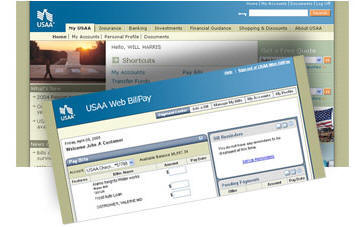 A
Frequent (Military) Mover's Dream Come True
A
Frequent (Military) Mover's Dream Come True
 A
Frequent (Military) Mover's Dream Come True
A
Frequent (Military) Mover's Dream Come True
No longer do you have to wait for bills to catch up with you.
![]() With Bill
Pay you can send a payment to virtually any
company or person (in the U.S.) with nothing more than an internet connection.
With Bill
Pay you can send a payment to virtually any
company or person (in the U.S.) with nothing more than an internet connection.
![]() Whether it
is a credit card company, electric bill, dentist, or rent/mortgage you can
schedule payments anyway you want: in the future, repeating, minimum or full
payment of the bill you haven't even seen.
Whether it
is a credit card company, electric bill, dentist, or rent/mortgage you can
schedule payments anyway you want: in the future, repeating, minimum or full
payment of the bill you haven't even seen.
![]() You can
even use Bill Pay to send money to friends and family.
You can
even use Bill Pay to send money to friends and family.
Bill Pay is easy and flexible, and
you’re in control
It’s as easy as this:
1. Set up your payee. You’ll need your bill to find the company address and your account number. In fact, for those bills to major corporations, most of the addresses are automatically filled in by your Bank. Setup is a one time event as the information you provide is stored for future use so making any subsequent payments is a matter of picking a date and amount.
 2.
Schedule
your payment. Tell your Bank
the amount you want to pay, and when you want the payment made. Usually payments
can be made within 2 to 5 business days, but they will let you know how much
time to allow for each payee – this is based on whether the payment is sent
electronically or through the mail.
2.
Schedule
your payment. Tell your Bank
the amount you want to pay, and when you want the payment made. Usually payments
can be made within 2 to 5 business days, but they will let you know how much
time to allow for each payee – this is based on whether the payment is sent
electronically or through the mail.
3. Your payment is sent. The Bank will deduct the money from your account and send it to the payee, exactly as you instructed. You can check payment status either through email verification, online with the Bank, or through your financial software.
That’s
it… If you want to get fancy:
Ø Choose to set up automatic payments. If your bill is the same amount each month, you can make the whole process work automatically if you want. Tell the Bank the payment amount and frequency, and they’ll take care of it.
 Ø
Make
automatic payments when the amount due varies each month. If you set up your payee
as an eBill (electronic version of your paper
bill) the Bank can pay the full amount, the minimum amount, or a sum you choose.
Ø
Make
automatic payments when the amount due varies each month. If you set up your payee
as an eBill (electronic version of your paper
bill) the Bank can pay the full amount, the minimum amount, or a sum you choose.
Ø Track your payment history. You can also use Bill Pay to keep track of your payment history, so you can look back a full year to monitor how much and when you paid each of your payees.
![]()